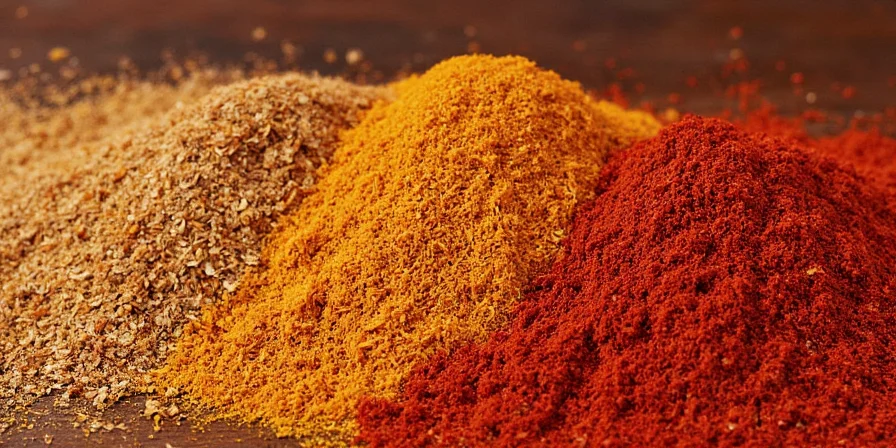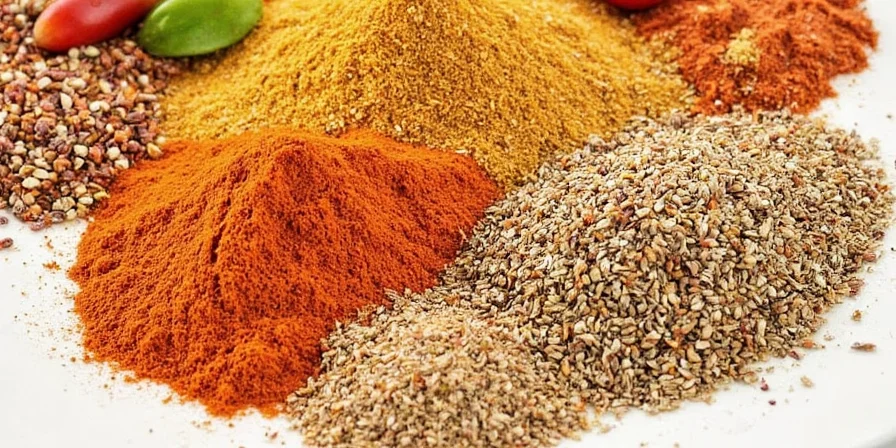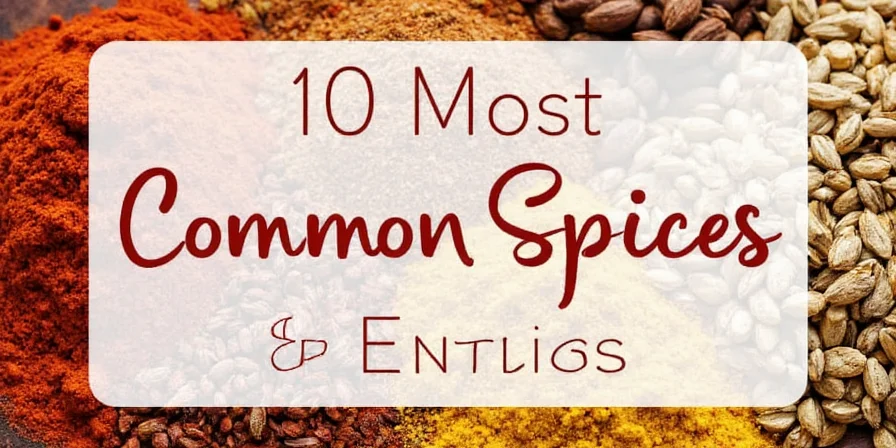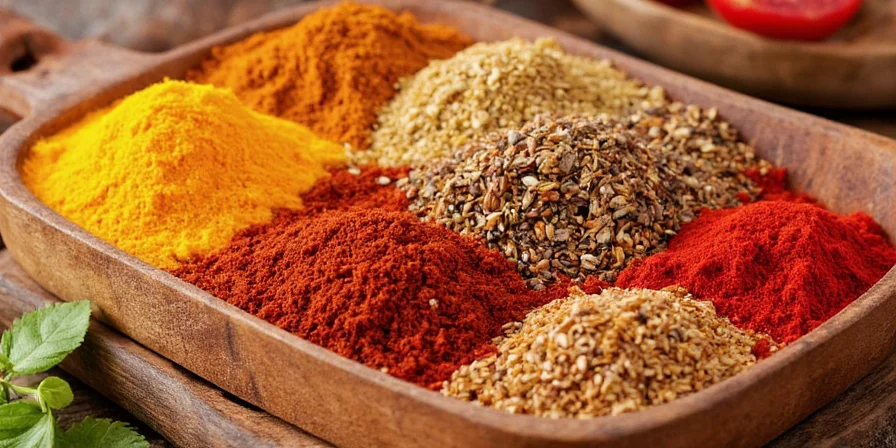If you're wondering which spices to buy first for your kitchen, here's the direct answer: Start with cumin, paprika, cinnamon, turmeric, garlic powder, oregano, chili powder, nutmeg, cloves, and coriander. These 10 spices form the foundation of 90% of global cuisines and will transform basic ingredients into restaurant-quality meals. This guide cuts through confusion with a practical, step-by-step approach specifically designed for beginner cooks building their first spice collection and home chefs seeking reliable daily essentials.
Unlike overwhelming lists, we prioritize what matters most: which spices to buy first, exactly how much to use, and simple storage tricks that keep them fresh longer. You'll learn basic pairings that work across cuisines without memorizing complex rules.
Table of Contents
- Your Starter Spice Kit (What to Buy First)
- Top 10 Essential Spices: Simple Guide
- Beginner Usage Basics
- Easy Flavor Pairing Chart
- Storage That Actually Works
- Spice Questions Beginners Ask
- What to Add Next
Your Starter Spice Kit: What to Buy First
Don't buy everything at once. Start with these 5 essentials that cover most cooking needs:
- Cumin - For tacos, chili, and roasted vegetables
- Paprika - Adds color to meats and stews
- Garlic Powder - Better than fresh for consistent flavor
- Oregano - Essential for tomato sauces and grilled foods
- Cinnamon - Works in both sweet and savory dishes
These five will cover 80% of your cooking needs. Add the remaining five after you've used your starter kit for 2-3 months.

Top 10 Essential Spices: Simple Guide
Here's exactly what each spice does and when to use it - no culinary degree required.
- Cumin: Earthy flavor for Mexican, Indian, and Middle Eastern dishes
- Paprika: Adds color and mild pepper flavor to meats and stews
- Cinnamon: Sweet warmth for baking and savory dishes like Moroccan tagine
- Turmeric: Golden color for rice and health-boosting properties
- Garlic Powder: Convenient garlic flavor without chopping
- Oregano: Classic Mediterranean herb for tomato sauces
- Chili Powder: Blend for tacos and chili (not the same as cayenne)
- Nutmeg: Warm spice for creamy sauces and holiday baking
- Cloves: Strong flavor for ham glazes and holiday drinks
- Coriander: Citrusy seed that balances spicy dishes

1. Cumin
When to use: Add to ground meat, chili, roasted vegetables, and bean dishes
How much: Start with 1/4 teaspoon per pound of meat or 4 servings of vegetables
Pro Tip: Toast whole seeds in a dry pan for 1 minute before grinding for deeper flavor in advanced recipes.

2. Paprika
When to use: Sprinkle on meats before roasting, add to stews and soups
How much: Start with 1/2 teaspoon per pound of meat or 4 servings
Pro Tip: Mix with oil to create a paste that sticks to meats better than dry application.

3. Cinnamon
When to use: Baking, oatmeal, coffee, and savory dishes like Moroccan lamb
How much: 1/4 teaspoon for baking, 1/8 teaspoon for savory dishes
Pro Tip: Cassia (common grocery store cinnamon) works for most cooking; save pricier Ceylon for delicate desserts.

Beginner Usage Basics
- Start small: Begin with 1/8 teaspoon per serving - you can always add more
- Ground vs. whole: Buy pre-ground for your starter kit; whole spices last longer but require grinding
- When to add: Add dried spices early in cooking for soups/stews; add to oil first for sautéed dishes
- Test freshness: Rub between fingers - if little aroma reaches your nose, it's time to replace
- Basic ratio: 1 teaspoon dried = 1 tablespoon fresh herbs (when substituting)
Easy Flavor Pairing Chart
| Spice | Best With | Beginner Recipe Ideas |
|---|---|---|
| Cumin | Ground beef, black beans, sweet potatoes | Taco seasoning, chili, roasted carrots |
| Paprika | Chicken, pork, eggs | Paprika chicken, deviled eggs, potato salad |
| Cinnamon | Oatmeal, coffee, apples, pork | Cinnamon rolls, apple pie, Moroccan chicken |
| Turmeric | Rice, lentils, roasted cauliflower | Golden milk, turmeric rice, lentil soup |
| Oregano | Tomato sauce, zucchini, feta cheese | Pasta sauce, Greek salad, grilled vegetables |

Storage That Actually Works
Keep your spices fresh longer with these practical tips:
- Buy small amounts: Purchase 1-2 oz containers rather than large economy sizes
- Store properly: Keep in a cool, dark place (not above the stove where heat degrades them)
- Check freshness: Replace ground spices after 6-8 months, whole spices after 12-18 months
- Simple test: If rubbing between fingers doesn't produce strong aroma within 5 seconds, replace
- Affordable solution: Use original containers with tight lids - no need for expensive storage systems

Spice Questions Beginners Ask
What's the difference between paprika and chili powder?
Paprika is pure ground peppers with mild flavor. Chili powder is a blend containing paprika plus cumin, garlic, and oregano. For beginners: use paprika for color without much heat, chili powder for taco seasoning and chili recipes.
How do I know if my spices are still good?
Rub a small amount between damp fingers. Fresh spices will leave noticeable aroma on your skin for 15+ seconds. If you barely smell anything, it's time to replace them. Ground spices typically last 6-8 months, whole spices 12-18 months.
Which spices should I buy first on a budget?
Start with cumin, paprika, garlic powder, oregano, and cinnamon. These five cover most cooking needs and cost under $15 total. Add turmeric, chili powder, nutmeg, cloves, and coriander after you've used your starter kit for 2-3 months.
Can I substitute fresh herbs for dried spices?
Yes, but use three times more fresh herbs than dried. For example, 1 teaspoon dried oregano = 1 tablespoon fresh oregano. Add fresh herbs near the end of cooking; add dried spices earlier to allow flavors to develop.
What to Add Next
After mastering these basics, expand your collection strategically:
After 3 months: Add turmeric (for golden rice and health benefits) and chili powder (for Mexican dishes)
After 6 months: Add nutmeg (for creamy sauces) and coriander (to balance spicy dishes)
After 1 year: Add specialty spices like cardamom or saffron for specific cuisines
Remember: Great cooking isn't about having every spice imaginable. It's about knowing how to use a few essentials well. With these 10 spices and simple guidelines, you'll create flavorful meals that impress without overwhelming your cabinet or your skills.











 浙公网安备
33010002000092号
浙公网安备
33010002000092号 浙B2-20120091-4
浙B2-20120091-4